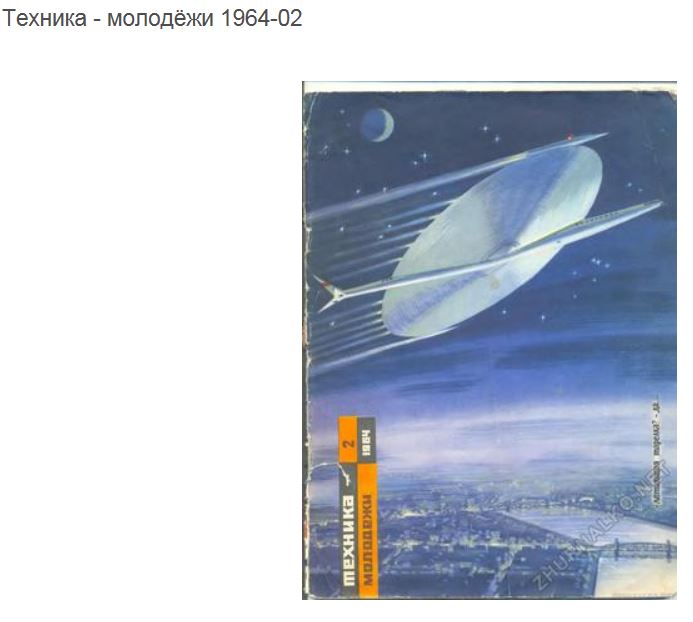 |
February 1964 Soviet Technology and Youth magazine cover |
Sukhanov's Discoplans
and Soviet saucer propaganda
In its January 1953 report on the UFO problem, the CIA's Scientific Advisory Panel on Unidentified Flying Objects noted
That the continued emphasis on the reporting of these phenomena does, in these perilous times, result in a threat to the orderly functioning of the protective organs of the body politic. We cite as examples the clogging of channels of communication by irrelevant reports, the danger of being led by continued false alarms to ignore real indications of hostile action, and the cultivation of a morbid national psychology in which skillful hostile propaganda could induce hysterical behavior and harmful distrust of duly constituted authority.
It is an intriguing fact that in spite of these Cold War fears, there seem to be very few cases where the Soviets unambiguously tried to exploit the potentially volatile UFO scene for propaganda purposes (assuming that the objects Senator Richard Russell saw were not actual saucer aircraft or deliberate hoaxes). Almost the only genuine example, and a rather tepid one at that, revolves around the only known Soviet disc-like aircraft project, the creation of a designer named Sukhanov.
Information on Sukhanov is very sketchy. According to A Guide to the Russian Federation Air Force Museum at Monino, by Colonel-General B. Korolkov, commander of the Russian Air Force Academy, and V. Kazashvili, the Museum's curator, the Soviet designer "M. Sukhanov" (first name unspecified) specialized in circular-winged aircraft.
According to Korolkov and Kazashvili, the Discoplan I, "of great size," was built in 1950 in Novosibirsk. The term "great size" seems to be an exaggeration or poor translation, since the diameter is given as 5 meters. Discoplan II, they claim, was built in 1960 at the Lavochkin plant (which ironically was where the SA-2 missile, which may have been responsible for the Russell sighting, was manufactured). It had a diameter of 3.45 meters. Both craft were unpowered gliders and were towed by Yak-12 lightplanes to altitudes of several thousand meters to conduct test flights.
The authors give the lift-to-drag ratio of the aircraft as 8 and claim that their descent velocity was 5 meters per second at only 6 to 22 kph. "In 1979...Sukhanov continued to develop the idea of the discoplane on the theory that it could be used for the recovery of spaceships in orbit," they claim.
Other sources give slightly different information and flesh out the picture somewhat.
The 1959 edition of Jane's All The World's Aircraft featured the small article below:
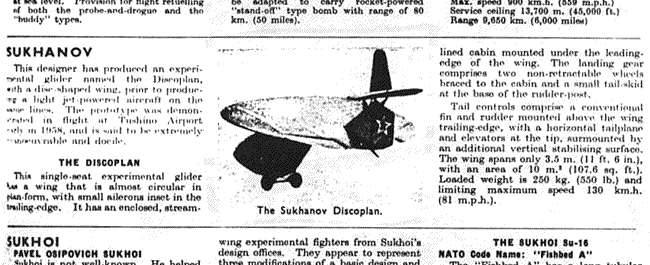
This Discoplan is now on display at Monino:
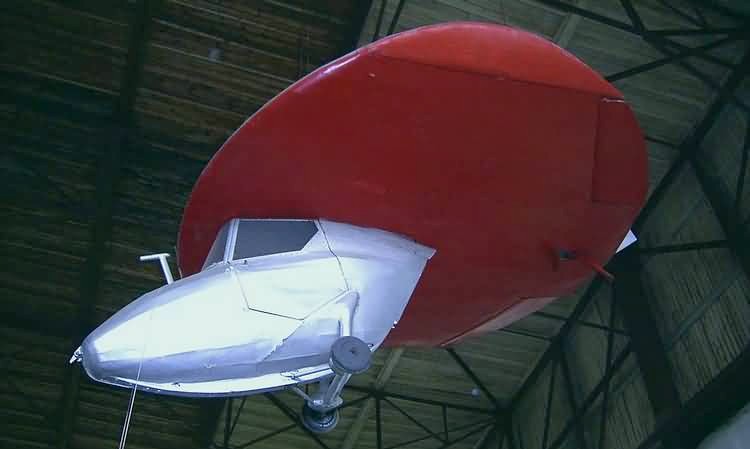
The existence of a 1950 Discoplan is questionable, but there definitely were successors to the 1958 design. However, below a 1957 newsreel shows a Discoplan 1 in flight. Click on the image to access the video.
According to Bill Gunston's exhaustive Encyclopedia of Russian Aircraft, a slightly larger Discoplan glider was built in 1960 and an improved model, with squared-off wingtips, was flown in 1962.
The photo below apparently shows the 1960 version, the Discoplan 2. These photos are very heavily retouched, but the aircraft's structure appears to have been based on a wooden or steel truss covered with lacquered canvas -- standard lightplane and glider construction. Apparently the disc-shaped vertical "fin" was designed to revolve on a horizontal axis like a bicycle wheel -- possibly to provide some sort of gyroscopic stabilization to the aircraft's control system via a system of cables and struts.
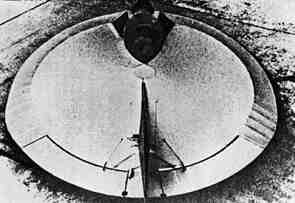
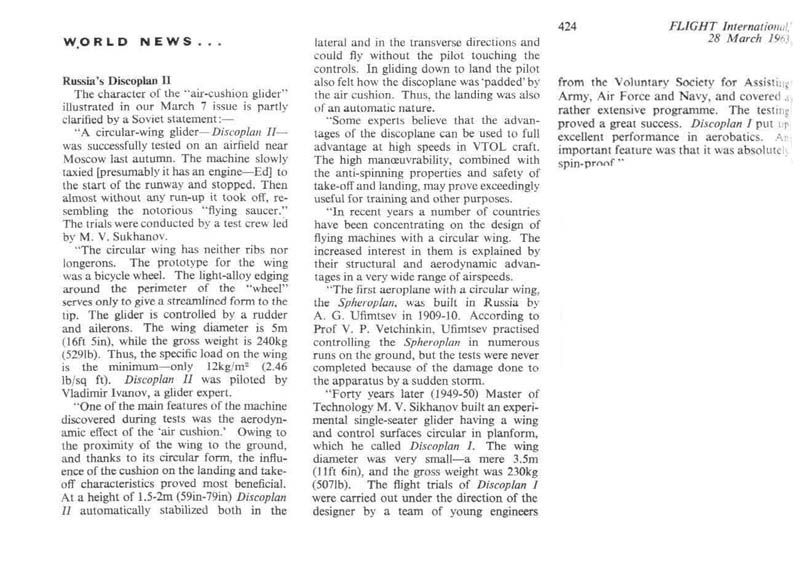
The two photos below show the 1962 glider, the Discoplan 3.
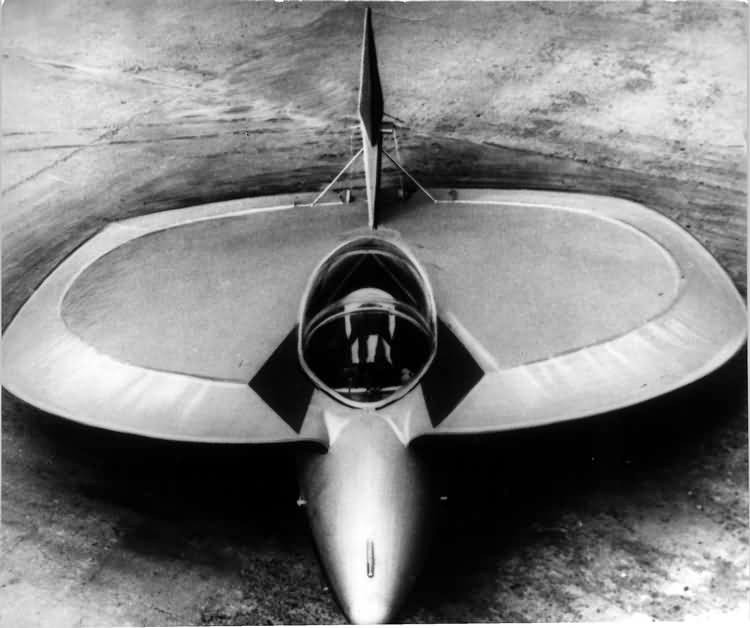

(via Steven Zaloga)
According to Gunston and other sources, Sukhanov's ultimate intention was to build a jet-powered Discoplan.
Saucer Propaganda?
From available evidence, the Discoplans were little more than gliders of unusual shape and had no special performance advantages. However, there is evidence that the Soviets decided to use them in a rather small-scale propaganda program designed to float the idea that the Discoplans were evidence of far more spectacular projects.
The launch of Sputnik seems to have marked a transition in the Soviet treatment of the UFO issue. Mirroring the US technique established with the release of Special Report 14 and the Avro "Silver Bug" story, a handful of press releases appeared in Soviet publications which seem deliberately designed to hint that saucer-like vehicles were being produced in the USSR. The day after Sputnik reached orbit, Sovietskaya Rossiya magazine published an article on a Soviet counterpart of the Avrocar, "a circular object with four ducted fans," designed by a Professor S. Zonshtein. That same month, a Russian VTOL test vehicle similar to the Rolls-Royce "Flying Bedstead" was revealed. "Subsequently, it was announced that the test rig was designed by a team of engineers named Rafaelianc, Kwashinin, and Lipschyn, under the leadership of Prof. Matviev and that many Soviet designers are working on VTOL aircraft...using similar techniques."
In March 1958, a sly article, purporting to describe a UFO sighting near Moscow, appeared in another Soviet journal:
Recently, not far from Moscow at an altitude of about three thousand meters, a strange object flying at great speed was seen. The witnesses maintained that it had exactly the shape of a disk, of relatively large dimensions. No one was able to say what this disk was, or where it came from. Very fantastic interpretations and hypotheses have been started by this incident. A little later, the disk came down toward the ground with a motion in spiral and started upward again, turned over and, suddenly speeding, disappeared behind a nearby forest.
The real significance of the report becomes clear when it is known that the Discoplan had just begun flight testing at Tushino airfield, not far from Moscow. The author of the apparent UFO sighting report was in fact the object's designer, Sukhanov.
It is virtually certain that a jet-powered Sukhanov Discoplan could not have been responsible for the Richard Russell sighting in 1955 - ostensibly it was constructed several years later (if at all) and in any case it would have had nowhere near the performance attributed to the Baku objects.
Sukhanov made an even more significant contribution to the UFO disinformation game in 1964, when he produced an article titled "Man Overcomes Gravity" for Yunyi Tekhnik (Technology and Youth) magazine. Somehow Frank Edwards acquired a copy of a translation of the article, which is interesting considering that the rather obscure magazine is not even held by the Library of Congress today. Evidently Edwards obtained it through a NICAP contact. Reading his account of the article leaves one with the feeling of being a party to a gigantic inside joke between Soviet and Western intelligence services. The magazine's cover illustration depicted a huge airliner-style jet-powered flying disk, and the article was accompanied by several illustrations of the 1962 Discoplan. Taking his cue from Wilbert Smith and Townsend Brown, Sukhanov claimed that his vehicle was capable of generating a gravitational field in order to lift itself and to generate a protective, anti-drag air cushion for high-speed flight.
According to Edwards, Sukhanov's article referred to "gravity research programs" being undertaken in the US. Sukhanov's information on these programs, Edwards said, was drawn from the August 15, 1960 issue of Aviation Week magazine. The issue in question contains no article on gravity research, but it does have a story on the US Air Force's interest in using the Avro saucers as space reentry vehicles. It could hardly be made clearer that the Soviets were completely aware of the behind-the-scenes reality of the American flying saucer story, as well as the US lenticular reentry vehicle projects. In a single article, they had managed to lump together the Avro projects, Townsend Brown's electrogravitics and Martin Kaplan's Convair antigravity project, UFO reports and references to the NASA hypersonic lenticular reentry vehicles.
Who was this propaganda designed to influence? It's hard to believe that any US intelligence analysts would have taken such an article seriously by 1964 - much had changed since the Robertson committee put its fears on paper.
